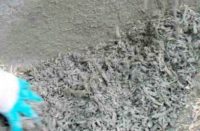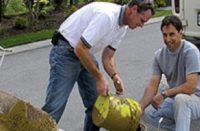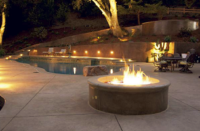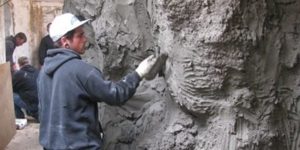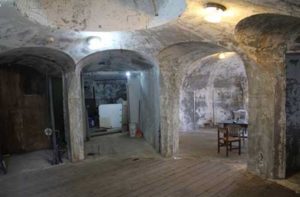
FlexCrete aerated concrete used to create cool, stylish homes.
The Navajo Nation has an urgent need for housing and employment on its vast reservation in Northern Arizona. The nearby Navajo Generating Station, a coal-fired power plant, has millions of tons of low-cost fly ash for sale.
The Navajo Housing Authority saw in the mountains of fly ash an opportunity to attack the housing and employment problems at the same time, long-term: by creating a new manufacturing plant that produces FlexCrete aerated concrete construction blocks.
FlexCrete is a form of aerated concrete that contains as much as 60 percent fly ash. Unlike traditional aerated concretes, it is not cured under heat or pressure, so it uses much less energy to produce. The company says the tiny air pockets make it stronger and lighter than cinder block, with greater acoustical and thermal insulation properties than typical wood frame or masonry homes.
The plant, which the Housing Authority owns and operates as Navajo FlexCrete, is essentially a franchise of FlexCrete Building Systems of Jordan, Utah, which is a subsidiary of Headwaters Resources, which also owns the power plant. Navajo FlexCrete celebrated its grand opening in April 2005 and is focusing on building homes for the Housing Authority, but leaders hope to branch out into Southwest construction markets in the future.
Architect Daniel Glenn says Navajo FlexCrete’s system works well with the Southwest climate, where insulation from the desert heat is a top priority. Glenn is design director of Arizona State University’s Stardust Center for
Affordable Homes and the Family, which is working with the Navajo Housing Authority on special projects on the reservation and in the Phoenix area.
Because of the high percentage of fly ash and the low amount of energy involved in production, FlexCrete makes a low-cost alternative for building materials, Glenn says. Furthermore, homes can be built without the added expense of furring and insulation between the exterior and interior wall. In fact, stucco can be applied directly to the interior as well as the exterior FlexCrete wall for a complete finish. The ASU program recently designed and built a FlexCrete home in this manner for a Navajo family. Glenn hopes to prove with monitoring this summer that even in the heat of the day, the inside temperature will remain below 80 degrees without air conditioning.
 The product works well in decorative designs, Glenn says, particularly with Southwest home styles. “Because it cuts so easily, there are a lot of options for design,” he says. The blocks come from the plant in lengths of up to 20 feet, and can be sawn like lumber. Glenn said that he even used a router and successfully molded edges without chipping.
The product works well in decorative designs, Glenn says, particularly with Southwest home styles. “Because it cuts so easily, there are a lot of options for design,” he says. The blocks come from the plant in lengths of up to 20 feet, and can be sawn like lumber. Glenn said that he even used a router and successfully molded edges without chipping.
